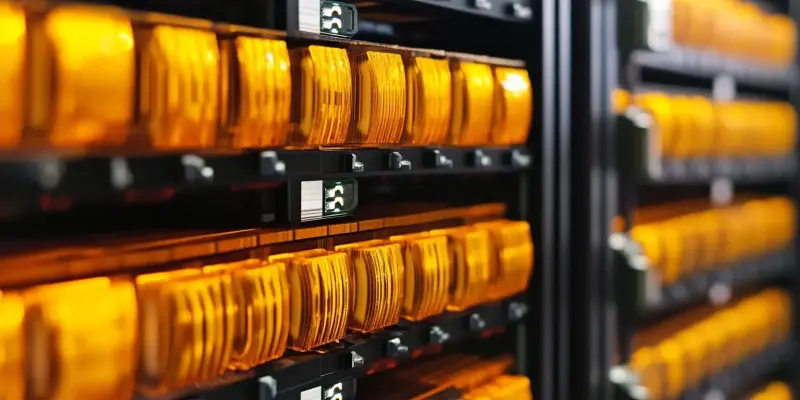In today’s digital age, we are witnessing an unprecedented explosion in the amount of data generated daily, with estimations predicting global data volumes to reach an astronomical 175 zettabytes by 2025. One might wonder how our existing storage technologies will cope with such staggering amounts of information. The answer lies in a remarkable innovation spearheaded by Professor Huriye Akdaş from Turkey, known as 3D Optical Data Storage (3D-ODS). This revolutionary technology promises to fundamentally transform our approach to data storage, offering unparalleled capacity and sustainability. Imagine a disc the size of a standard DVD capable of storing over 1 petabyte of data. This is the extraordinary potential of 3D-ODS, representing a monumental leap from traditional hard drives which would require thousands to match this storage capacity.
Extraordinary Data Density and Storage Capabilities
The core advantage of 3D-ODS lies in its extraordinary data density. Traditional hard drives, despite their advancements, are becoming increasingly inadequate for handling the ever-growing data volumes. This pioneering technology enables data to be stored in three dimensions (vertically and horizontally), drastically increasing storage capacities without expanding physical storage space. A 3D-ODS disc, similar in size to a standard DVD, can seamlessly store more than a petabyte of data. To put that in perspective, several thousand traditional hard drives would be required to accommodate the same amount of information.
Furthermore, the sheer volume of data that 3D-ODS can handle is not its only impressive attribute. The technology is also designed with an eco-conscious approach, using organic materials. This aligns 3D-ODS with the global push towards sustainability and environmentally-friendly innovations. The use of organic materials not only minimizes the environmental impact but also enhances the technology’s attractiveness for organizations committed to reducing their carbon footprint. By integrating these eco-friendly aspects, 3D-ODS not only addresses data storage challenges but also contributes towards building a sustainable future.
Applications in Key Sectors
Several key sectors stand to gain immensely from the advent of 3D-ODS. In the healthcare industry, the storage technology could revolutionize management practices for extensive digital health records and genomic data, thereby significantly enhancing patient care and expediting research initiatives. High data volumes characteristic of genomic sequencing and digital health records require sophisticated and efficient data storage solutions. In finance, where vast troves of transactional data and stringent regulatory requirements abound, 3D-ODS offers secure, efficient means of managing this crucial information. From daily transactions to long-term data archival, the financial sector’s data needs are bound to grow.
Moreover, academic institutions, especially those involved in extensive research projects, may find in 3D-ODS the solution to their data handling and accessibility issues. High-capacity storage that is both reliable and easy to access will facilitate consistent progress in research, ensuring that critical data is not only preserved but also regularly retrievable. This accessibility can drive forward numerous studies and academic inquiries, bridging the gap between data generation and utilization.
Challenges and Considerations
While 3D-ODS promises remarkable advancements, it also faces challenges in widespread adoption. One significant barrier is the initial cost associated with the development and deployment of this innovative technology. Smaller organizations, in particular, may find these upfront costs prohibitive. Furthermore, 3D-ODS is still in its developmental stage; thus, it requires further refinement and rigorous testing before it can be scaled for widespread implementation.
Security is another critical aspect that must be addressed. As data threats continue to evolve, advanced encryption and storage methods become paramount in safeguarding sensitive information. The introduction of organic materials for constructing 3D-ODS discs brings new considerations regarding data durability and integrity over time. Ensuring the longevity of the data stored and protecting it from potential corruption or degradation remains a paramount concern that needs to be meticulously addressed.
Future Trends and Conclusions
The introduction of 3D-ODS technology stands to significantly benefit several key sectors. In healthcare, this advanced storage solution could transform the way extensive digital health records and genomic data are managed, thereby improving patient care and speeding up research initiatives. The high data volumes involved in genomic sequencing and digital health records demand efficient and sophisticated storage solutions. Similarly, the finance sector, dealing with vast amounts of transactional data and strict regulatory requirements, can leverage 3D-ODS for secure and efficient data management. This encompasses everything from daily transactions to long-term data archival, as the financial sector’s data needs continue to grow.
Academic institutions, particularly those engaged in extensive research projects, also stand to gain substantially from 3D-ODS. High-capacity storage that is both reliable and easily accessible will support consistent research progress, ensuring that critical data is preserved and readily accessible. This improved accessibility can drive numerous studies and academic inquiries forward, narrowing the gap between generating and utilizing data.

